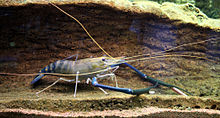Macrobrachium rosenbergii
| Macrobrachium rosenbergii | |
|---|---|
 |
|
| Scientific classification | |
| Kingdom: | Animalia |
| Phylum: | Arthropoda |
| Subphylum: | Crustacea |
| Class: | Malacostraca |
| Order: | Decapoda |
| Infraorder: | Caridea |
| Family: | Palaemonidae |
| Genus: | Macrobrachium |
| Species: | M. rosenbergii |
| Binomial name | |
|
Macrobrachium rosenbergii De Man, 1879 |
|
| External identifiers for Macrobrachium rosenbergii | |
|---|---|
| Encyclopedia of Life | 344690 |
| ITIS | 96343 |
| NCBI | 79674 |
| WoRMS | 220137 |
Macrobrachium rosenbergii, also known as the giant river prawn or giant freshwater prawn, is a commercially important species of palaemonid freshwater prawn. It is found throughout the tropical and subtropical areas of the Indo-Pacific region, from India to Southeast Asia and Northern Australia. The giant river prawn has also been introduced to parts of Africa, China, Japan, New Zealand, the Americas and the Caribbean. It is one of the biggest freshwater prawns in the world and is widely cultivated in several countries for food. While M. rosenbergii is considered a freshwater species, the larval stage of the animal depends on brackish water. Once the individual shrimp has grown beyond the planktonic stage and becomes a juvenile, it will live entirely in freshwater.
It is also known as the Malaysian prawn, freshwater scampi (India), or cherabin (Australia). Locally, it is known as bara chingri in Bangladesh, udang galah in Indonesia and Malaysia, uwang or ulang in the Philippines, and koong yai in Thailand.
M. rosenbergii can grow to a length over 30 cm (12 in). They are predominantly brownish in color but can vary. Smaller individuals may be greenish in color and display faint vertical stripes. The rostrum is very prominent and contains 11 to 14 dorsal teeth and 8 to 11 ventral teeth. The first pair of walking legs (pereiopods) are elongated and very thin, ending in delicate claws (chelipeds) which are used as feeding appendages. The second pair of walking legs are much larger and powerful, especially in males. The movable claws of the second pair of walking legs are distinctively covered in dense bristles (setae) that give it a velvety appearance. The color of the claws in males vary according to their social dominance.
...
Wikipedia

